Long-time Pruned readers (which I encourage you all to become, if you are not already) might remember a short post from January 2007, which introduced Carlos Barrios, a former accountant turned official Mexico City sewer diver.
These Washington Post descriptions of his workday spent immersed in “garbage, bacteria, excrement, dead animals—even the occasional murder victim” certainly stuck with me, so when the organizers of Postopolis! DF asked me to select five guest speakers with a unique and intriguing perspective on the geography of Mexico City, I set my heart on tracking down a sewer diver.
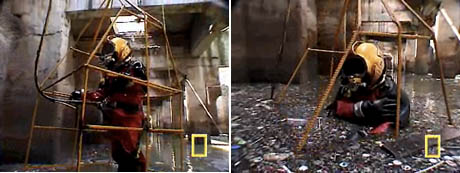
IMAGE: Stills from a short 2006 National Geographic video about Mexico City’s sewer divers. Carlos Barrios is lowered into the sewer in the cage.
After all, the infrastructure of waste disposal is the (frequently invisible) corollary of consumption, and who better to map its patterns and peculiarities than someone who spends all day submerged in the city’s various excreta? In addition, the sewage system is intimately tied to the city’s fascinating—and pressing—water issues: indeed, both are managed by one government agency, the Sistema de Aguas de la Ciudad de México.
The topic of water actually came up earlier during the week at Postopolis, when one of Jace Clayton’s invited speakers, architect and urban planner Jorge Legoretta, traced Mexico City’s hydrological history and predicted that it will suffer a serious flood in the next twenty to thirty years.

IMAGE: Jorge Legorreta compared the basin in which Mexico City sits to the traditional molcajete, a basaltic mortar used to make salsas and guacamole.
In his fascinating presentation, Legorreta explained that Mexico City lies in a basin ringed by volcanoes, into which forty-five different rivers drain (some glacier-fed and seasonal, others year-round). Indeed, the city’s Aztec precursor, Tenochtitlan, was actually built on an island surrounded by lakes and criss-crossed by canals. These lakes and waterways were promptly drained by the Spanish conquistadors in order to deprive the Aztecs, with their lightweight and manoeuvrable canoes, of any military advantage.
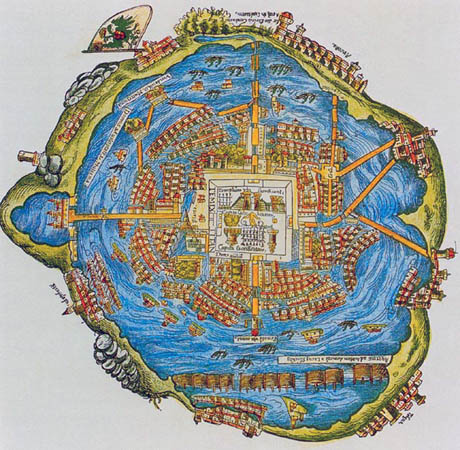
IMAGE: The Aztec capital Tenochtitlan was a city of canals and artificial islands built on a lake.
To make matters worse, Mexico City is now pumping water up from its aquifer so fast that it is sinking an average of seven centimetres per year (up to forty-four centimetres per year in some parts of the city). As a result, many older parts of the city’s mixed wastewater and sewage system have lost their grade, making the task of draining the city during the rainy season’s intense thunderstorms even more challenging.
Until a recent renovation in 2008, the system’s principal canal—“the most important pipe in the country” according to Ramon Aguirre, Director of the Sistema de Aguas—had not been emptied and repaired in thirty-five years.
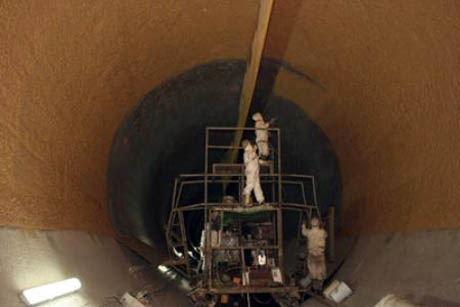
IMAGE: A team carrying out the first maintenance operations in more than thirty-five years during a 28-day shut down of the Emisor Canal in 2008. Photo via Water and Waste Water International.
To maintain this fragile, overburdened system, Mexico City relies on a team of two divers—the only sewage divers in the world. On Saturday, June 12, at Postopolis! DF, we were lucky to be joined by one of them: Julio Cou Cámara.
A cheerful and charming middle-aged man with a couple of missing teeth and an evident pride in his work, Julio described his twenty-seven year career diving blind beneath the streets of the city, clearing blockages and repairing infrastructure in order to prevent the kinds of catastrophic floods predicted by Legorreta. His presentation is transcribed below.
•••
Julio Cou Cámara: Good afternoon, my name is Julio and I’m a diver in the sewage here in Mexico City. What I do is a bit weird. Most people, when I tell them that I’m a diver, they think, “Oh wow, that’s beautiful—the ocean and the beach.”
But no, we are divers of the sewage.
I’m part of a team, and we work for the government in DF, in the Sistema de Aguas. We’re a water emergency team, so we participate in everything that has to do with flooding and repairing drainage systems. Under the city, under the streets where you walk, that’s where we dive.
What we mostly do is maintenance. We repair pumps, we take out debris—we take out bodies of animals, bodies of people, and all the rubbish. There’s so much rubbish in the drainage system, it’s very harmful to us and to the city.
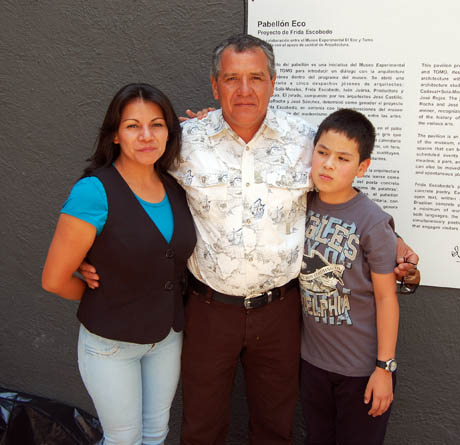
IMAGE: Julio with his family at Postopolis! DF.
People are always wondering why there’s so much flooding in the city. I can tell you that the city floods because of all the rubbish that creates blockages in our drainage system. If we were maybe a bit more conscious about rubbish and we didn’t throw it on the street, we wouldn’t have this many flooding problems in the city. People complain—they say, “There’s almost a lake in the street.” Well, yeah—that lake is there because of your rubbish.
The drainage system is constantly being maintained—all year long, twenty-four hours a day, there are people working. They need a diver when they can’t stop the pumping plant, because if they stopped it, the city would be flooded. That’s when they ask for my help. We go there and we see what the problem is and we do the job.
We work blindly in the black water. It contains animal poo, human poo, hospital waste… any kind of pollution you can think of. All of that is in the sewage water. That’s where we work. Right now there are only two of us diving for Mexico City.
I brought some of my equipment. Many people think we scuba dive, but no: we use specific equipment. It’s technically quite different—we have different air hoses and compressors, and so on. Because we can’t see what we’re doing and it’s completely dark down there, we don’t have the same instruments. There are people on the surface with computers telling me where I’m going and what I’m doing.

IMAGE: Julio demonstrates his sewage diving equipment to the audience at Postopolis! DF
This is my helmet or mask. [lifts up helmet] It’s quite heavy. Inside, we have a microphone and headphones so that we can communicate with the surface. They give us instructions from above.
This is my drysuit. [lifts up drysuit] These Norwegian suits that we have, they’re one-piece suits that are hermetically sealed. I could it put on over what I’m wearing right now and dive, and my clothes wouldn’t get wet at all. I’d just put on my gloves and attach the air hose and then I’d be ready to start working.
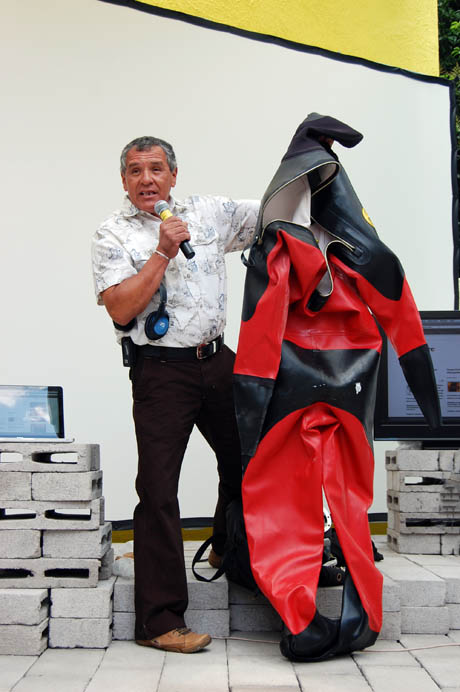
IMAGE: Julio demonstrates his sewage diving equipment to the audience at Postopolis! DF
People often ask me what I see down there. Do I find money or jewellery? No, you can’t really see any of those things. Montezuma’s treasure may be down there, but I will most likely never find it, because you can’t see anything—all you can do is feel blockages.
In terms of things we come across: we find lots of cigarette butts. I’ve had blockages caused by pieces of carpets, pieces of cars, or even body parts. Removing these kinds of things from the sewage is part of our work. People who work nearby or are walking past think, “Look at that crazy guy, he’s getting into the sewage.” But yeah, of course—that’s just what we do.
A normal day for me… well, what can I tell you? I go into the office, and if there are no emergencies then we work on maintaining the equipment. This equipment has to be in one hundred percent perfect condition—it mustn’t fail. My other colleague and I have our gear ready at all times. We work during the night as well as during the day. It’s not as though day or night makes a difference for us, because we can’t see anything down there anyway.
There are about fifteen pumping plants around the city and they vary in depth from eight to fifteen and even twenty metres. The deep sewage pipes in Mexico City are from fifty metres to two hundred metres below the surface. There are 650 kilometres of pipes. All of the city’s waste-water and sewage runs through these pipes, and most of it ends up going all the way to the state of Hidalgo.
Sewage leaves the loo in your house—that’s the primary source—and it goes to a secondary collection system in the street, and then it goes down to the deep sewage.
I’m not sure what else I can tell you. I’m fascinated by the job that I do. Even though not many people see it or know about it, I believe we do a very important job for all of us. Sometimes you can’t stop the pumping plant or you can’t dig up the street and get to the sewage pipes from the surface. That’s when we come in. It’s a very satisfying job. I like knowing that I am part of a system working to help keep the city safe.
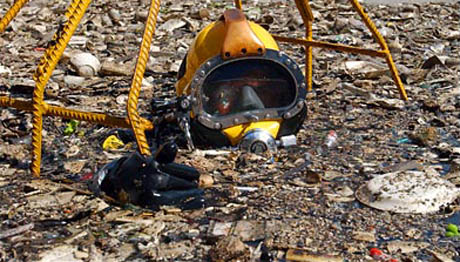
IMAGE: Diver Luis Covarrubias pictured being lowered into Mexico City’s sewers in 2006. Photo by Edward A. Ornelas for Metro.
I guess the most important thing I can say is: don’t throw rubbish in the street. Not because I want to be out of a job, but because flooding is one of the biggest challenges that Mexico City has. Rubbish and our water problems go hand in hand.
Thank you so much for this invitation, and if you have any questions, I’ll be glad to answer them.
Edible Geography: When you’re in the sewers, do you notice a difference between different neighbourhoods and parts of the city based on the kinds of debris you encounter or the smells or sounds? I know you can’t see anything, but can you sense what is above you in other ways?
Julio: Actually, I can dive for ten or fifteen minutes to unblock a plant, and then come to the surface for a rest, and when I go down again, it’s changed completely. The water moves constantly and it carries a lot of rubbish, which could be anything—we never know what the water will bring next. But I would say that, more or less, I’m like a blind person that starts feeling and seeing with my other senses, so that I can identify if something is a tree trunk or a tyre or whatever. But many times, I can take something out, and then two minutes later there’s another obstruction. What I’m feeling always changes, depending on what the water brings.
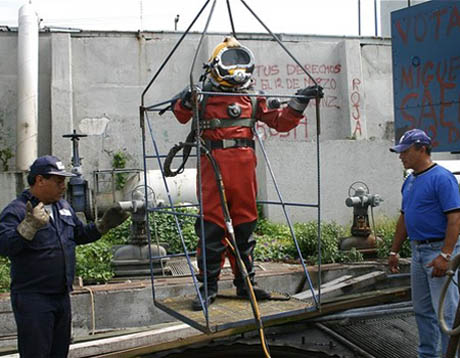
IMAGE: Carlos Barrios being lowered into the sewers. On the right, in the blue T-shirt, is Julio Cou Cámara. Photo by Mary Jordan for The Washington Post.
Audience Member: What’s the speed of the water down there? I have to imagine that it’s a little redundant to ask you how dangerous your work is, but what are the specific dangers that you find down there? Could the flow just carry you away?
Julio: The water moves at about five or six kilometres per hour on average. It depends on where you are in the system and on the slope of the pipe at that point. It can go really slow or really fast depending on the pumping system and how close you are to it.
The dangers that we face are not normal diving dangers—decompression and all that. The main danger that we face is getting cut somehow, because the rubbish is filled with glass, nails, syringes—all kinds of sharp things. If the suit was cut and we got an open wound, that’s an infection for sure.
Another danger that we have to deal with is when you’re taking the pieces out. We remove really large pieces—a half tonne or more, even three or four tonnes sometimes. We do that with cranes, but we have to be careful to move out of the way so that the piece doesn’t swing and hit us or fall on us.
Our air and our communication comes from a cable that is attached to the helmet, and if that cable got stuck or detached, or breaks, that would be really dangerous. Luckily, up until now, we haven’t had any problems with that.
Joseph Grima: If there were one piece of technology that could be invented to make your job easier, what would it be?
Julio: It’s a difficult question. We’ve tried a lot of different lamps, for example. We’d love to be able to see down there, but the water is so dirty and it’s got so many particles in it that the light reflects off everything and bounces on your eyes and you still can’t see. Eight hundred watts—one thousand watts even—and I can’t even see my own hand in front of my face. Apart from something that could help me see down there, I can’t think of anything. Fancy things like a robot or a submarine wouldn’t really help with the kinds of things I do. And we’d still be in the same situation: we can’t see anything down there, so we have to feel it.
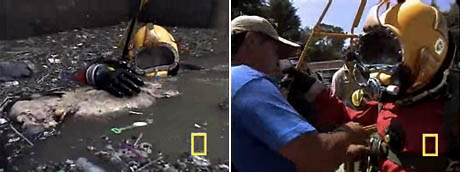
IMAGE: Stills from a short 2006 National Geographic video about Mexico City’s sewer divers. On the left, Carlos Barrios removes a dead dog from the sewer, on the right, Julio Cou Cámara fastens Barrios into his suit.
Edible Geography: In your free time or holidays, do you dive for fun in the ocean?
Julio: Yes. I like going to the beach and I love diving. I do go diving for fun, because it’s another world. The sea is one world, and the sewage is another world. In the sewage I can’t see anything and—sorry for the word—there’s shit everywhere, and in the sea I see fishes and it’s beautiful. I just like diving, so I like both.
Daniela Hernandez: What kind of protection do you receive because of the risks you take?
Julio: As sewage divers, we are paid a bit more than the usual government salary for the risk that we take. We also receive extra medical benefits. Sometimes we even have an ambulance with us, waiting at the surface in case anything happens.
Audience Member: Can you take me into the sewage system?
Julio: No, no, we can’t take anyone down into the sewage. It’s too dangerous. Maybe you’ve been hearing about what they’ve been finding now that they’ve been closing the pipes for repairs. When the rubbish rots, it’s toxic and very corrosive. The governor of the city came down to see the repair work but we had to put him in special equipment because there’s a lot of toxic gases down there.
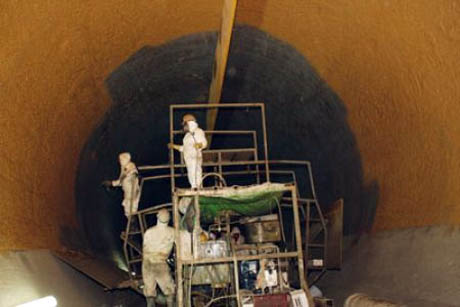
IMAGE: Teams carrying out the first maintenance operations in more than thirty-five years during a 28-day shut down of the Emisor Canal in 2008. They are wearing respirators, goggles, suits, and gloves. Photo via Water and Waste Water International.
Audience Member: Sometimes I feel like my job is not that great and my office is not adequate to my needs—the internet connection is too slow or the coffee machine sucks—but still, what on earth motivates you every day to get up and work in the sewers?
Julio: Honestly, what motivates me is the pleasure I get in my work. I’ve been working for twenty-seven years in the sewage of Mexico City. I started to swim when I was eight years old; I was a swimming teacher and a diving teacher. My whole life I’ve loved being in water, swimming and diving.
When they offered me this job, I did think, what am I doing, agreeing to spend every day swimming in the city’s sewage? But it gives me such pleasure and personal satisfaction to do my job and know that I’m doing a lot of good for a lot of people without them knowing. My wife knows that when the news shows a hurricane or a big thunderstorm coming, I start getting antsy. She’ll say, “What, you want to go and work now, or what?” I think it’s the adrenaline. I just want to get down there and work.
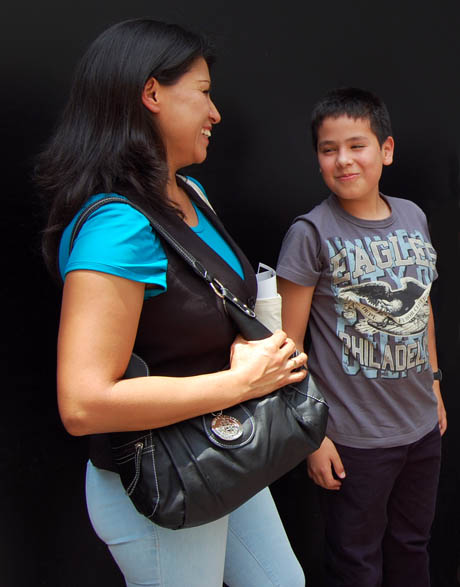
IMAGE: Julio’s wife and son at Postopolis! DF.
Ethel Baraona Pohl: What sort of training do you have before you start doing this kind of work?
Julio: When I started working, I was already a sports diver. I already knew scuba equipment from diving in lakes or the ocean—but I never thought I was going to dive in sewage! The equipment was really interesting to me: it’s very specific equipment that I would never be able to get my hands on otherwise.
Otherwise, the other requirement for being a sewage diver is that you’re not disgusted by the water, because sometimes we arrive at the place and it really smells. For some people, that smell can be unbearable. We’re so used to it, we don’t even smell it anymore. When I come back up to the street from being down in the drains, people can smell me, but I can’t smell it at all.
So basically, as long as you’re not disgusted by the sewage and you like diving, you are qualified to do this job.
Audience Member: Nicola said that you are the only sewage diving team in the world. How do other cities deal with blockages? Why is Mexico City’s sewage system different?
Julio: That’s my understanding, too: we are the only ones in the world that dive in the sewage. I’m not sure, but I think perhaps there aren’t as many people living in some of these other cities—and also in other parts of the world they have a culture of throwing their rubbish in the bin. They don’t pollute the water so much. That respect for the water system doesn’t exist in Mexico City, so that’s why we need a sewage diving team.
Edible Geography: What’s the weirdest thing you’ve come across down in the sewers?
Julio: It’s all pretty weird. One time we took out half of a Volkswagen. How did it end up there? We don’t know. One time we took out a fifteen metre roll of carpet that was obstructing a whole pipe. Really, anything you can think of, we can find it in the sewage. It’s a dump yard. That’s the problem.
Audience Member: I know you get instructions from the surface, but what tools do you have to get your orientation down there and navigate back to the surface in the dark?
Julio: We know the plans of the system very well. We know how all the pipes and pumps and different parts work and how they’re made. If they tell me go to plant X because a pump is stuck, I know exactly how that pump is situated and how it works. So we go in with a pretty good idea of the layout.
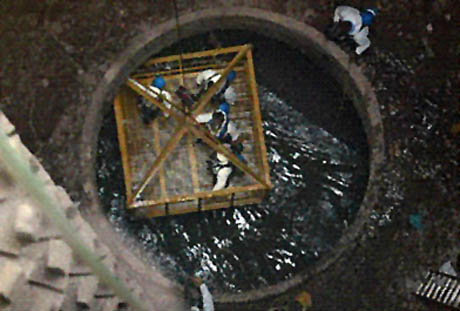
IMAGE: Divers being lowered into the sewer in a cage. Photo by Roberto García Ortiz / La Jornada via
If we go in to do a search for a body, for example, and we’re not in the parts we know well, near the pumping plants, we really depend on the person on the other end of the cable. He’ll say, for example, that you’re going to get out of the basket that you’re lowered in on, and you’re going to walk right. He can see a little dot on his screen that tells him where I am, so he can say, no, no, you’ve gone too far, or whatever. We rely completely on the cord that links us to the surface.
Edible Geography: Do you often feel fear, or have there been particular moments when you thought something might go really wrong?
Julio: Fear is always there. I can’t tell you that I’m ever not afraid. When they tell me I’m going to dive I always get really nervous. Mentally, I go over everything I might need to do and imagine every problem that I might encounter.
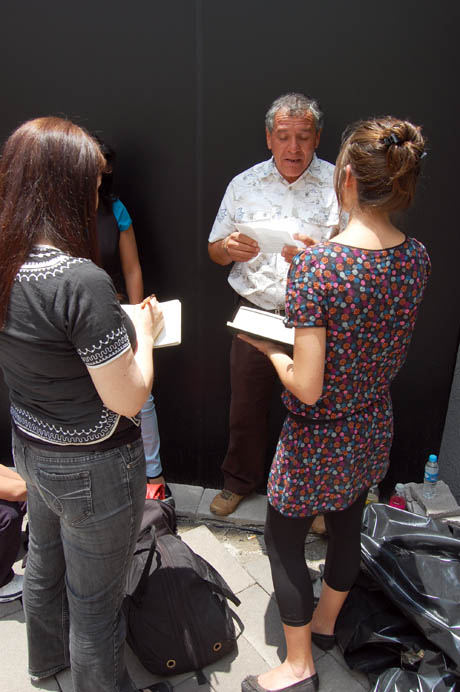
IMAGE: Julio answering more audience questions after his presentation at Postopolis! DF.
We put a lot of trust in the people that are up there at the surface, operating the crane and the communications cable. They’re working to keep us safe. Still, we’re always afraid. I can come up and rest for a half hour and the fear is still there when I go back down.
Edible Geography: How often do you dive, on average? Are there particularly busy times, such as in the rainy season?
Julio: Normally we dive between three and four days per month. A dive can last for ten minutes or six hours. We come up and rest, and then we continue, so sometimes we’re out there for thirty-six hours straight, if it’s a bad blockage. In the rainy season, it’s much more intense. We could be diving everyday in the rainy season. We have to be ready at all times throughout the year, though.
[NOTE: Tracking down a sewer diver is not easy, particularly if you (like me) don’t speak Spanish. I owe a huge thanks to the awesome and persistent Daniela Hernandez, who ended up submitting memos, faxing forms, and repeatedly visiting the dusty, filing-cabinet and index-card-stuffed headquarters of the Sistema before eventually securing a permission slip from Chief Aguirre himself.
I’m also extremely grateful to Julio Cou Cámara and his family for giving up several hours on a Saturday (in the rainy season!) to present at Postopolis! DF, and to the heroic anonymous translator whose efforts meant Julio and I could communicate in real-time, despite not having a word in common.
This post is part of a series of reports from my time in Mexico City as part of Postopolis! DF, which was presented by Storefront for Art and Architecture from June 8 to June 12, 2010. For more about Postopolis! DF, including my fellow bloggers, their speakers, and the sponsors and organisers (to whom I am very grateful), visit www.postopolis.org.]
9 Comments
Just superb to read – fascinating guy – I’m envious !
Thank you for taking the time to do this interview and publishing this story. ¡Me encantó!
I think he’s pretty brave going down there. I wouldn’t go down because I’d barf as soon as I went down.
wow, this is one of the best things i’ve read in a long time.
Hi there–Thanks for your great article. I linked it to my blog above and got a great response. Saludos, Jim Johnston, Mexico City
fantastic guest & recap Nicky! especially since I missed the diver in DF.
very valuable archival work going on here, I’m encouraged to up my Post-Postopolis post game.
That is one of the most unusual and fascinating stories I have ever read! God, I love this country!
Hi Nicky
Just a quick note to tell you that is amazing the work you’re doing with this archive of your guest’s talks!
I can feel like I’m inside a teleportation/time machine, travelling to the past and listening to Julio’s talk again… so, just thanks!
Some of the in-action photographs are stomach turning! Julio must have an iron stomach!
Great post and it reminded me that I’d heard about NYC’s sewer divers recently. Check out WNYC.org here http://blogs.wnyc.org/news/2010/06/16/city-unveils-new-sewer-cleaning-trucks-that-suck/.